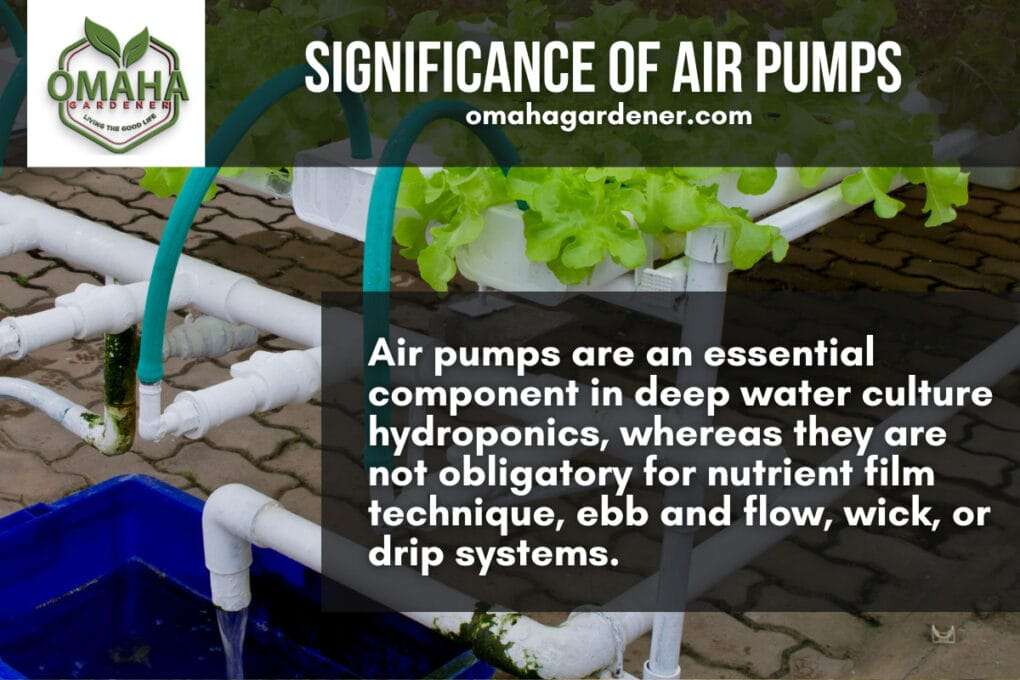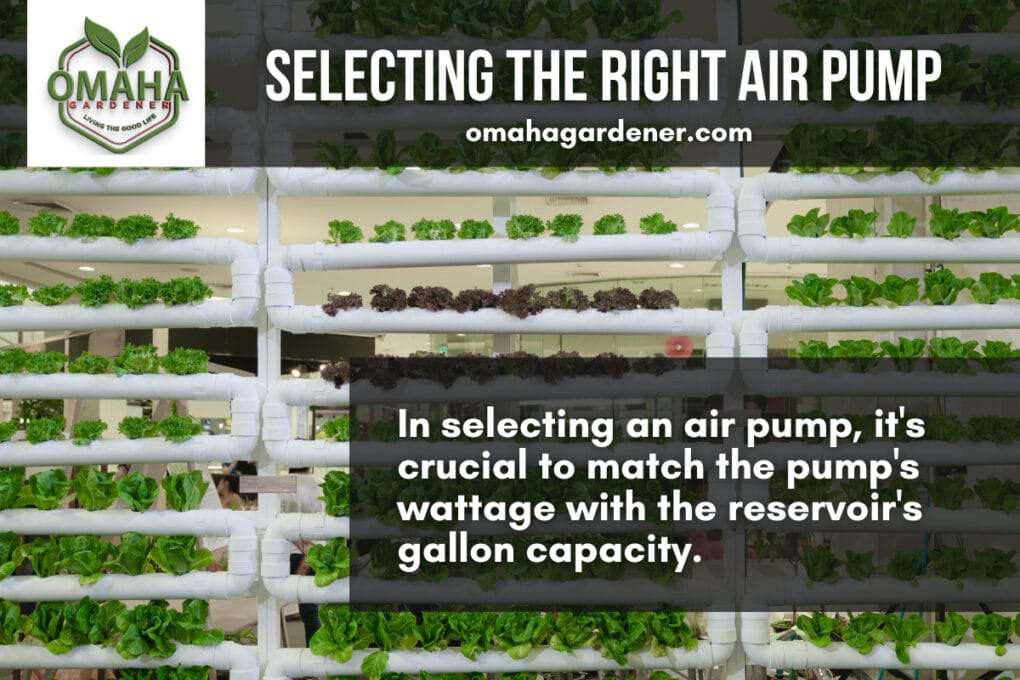
Okay, so you're diving into the world of hydroponic gardening, and there's this unsung hero in the mix that's quietly changing the game. Meet the hydroponics air pump. It might not catch your eye right away, but trust me, it's like the engine of hydroponic systems. Think of it as a cool partnership between oxygen and water that gives your plants the boost they need to thrive. But here's the big question: Do you really need air pumps in hydroponics? Are Air Pumps Required in Hydroponics? Let's break it down.
Table of Contents
Ever wondered why air pumps are the rock stars of hydroponic setups? And what's the deal with the perks they offer for your nutrient reservoir and those plant roots?
As we dive into the nitty-gritty, we'll spill the beans on these air pumps and how they light up the way to healthier, happier hydroponic systems.
Air Pumps in Deep Water Culture (DWC)
Turns out, not all hydroponic systems absolutely need air pumps. (I will reveal more of this before I end this article!) But, if you're using something called deep water culture (DWC), having an air pump can be a smart move. Why? Well, in DWC, plant's root system chill out underwater for a long time, and just like us humans and animals, they need oxygen to breathe.
Think about it like this: imagine spending a whole day submerged in a pool. That's a challenge even I couldn't conquer! I'd probably last only about a minute without air. Why? Because we all need oxygen to survive in situations like that.
It's the same deal for the roots of your plants. They're alive too, and they require oxygen to breathe and carry out their life processes, like growing and making fruits.
So, for hydroponic setups like the deep water culture method where roots are soaking in water a lot, an air pump can save the day. It adds extra oxygen to the water that would otherwise be still. This boost of oxygen helps the roots grow strong and healthy.

Significance of Air Pumps
See, in methods like nutrient film technique, ebb and flow, and wick systems, plant roots aren't constantly soaked in water. There's enough air around them for a cool thing called gas exchange to happen.
Wait, gas exchange? That's when roots let out carbon dioxide and take in oxygen – just like we breathe! This is how they do their natural life stuff. I'll dig into this a bit more below!
So, remember, it's not one-size-fits-all for air pumps in hydroponics. It depends on how the roots are hanging out in water. Just think of it as giving plants a breath of fresh air!
What Does a Hydroponics Air Pump Do?
Let's dive into why air pumps are so handy in hydroponics, especially when you're doing that DWC system. These machines do three cool things: they help with getting the right air mix, they keep things from getting too hot, and they make sure all the good plant food is spread around.
1. Gets the Right Air Mix
In hydroponics, air pumps make sure there's a good mix of gases going on. They create bubbles that let oxygen come into the water and carbon dioxide go out. Why is this important? Well, when there's enough oxygen hanging around, plant roots can do their job of passing water and nutrients around the plant.
Let me break it down a bit. You know that stuff called dissolved oxygen? It's just the amount of oxygen that's hanging out in the water. Think about it like the air in an aquarium that fish breathe – that's dissolved oxygen at work!
And guess what? Plants are like fish in their own way. They need oxygen too, and their roots do this cool thing called cellular respiration to get it. That's just a fancy term for how they breathe.
So, that's why people suggest using air pumps in hydroponics, especially if you're doing the deep water culture style. When you add an air pump to your setup, it's like giving your plants' roots a breath of fresh air.
Think about those little bubbles that pop up when air pumps do their thing. Those bubbles aren't just empty; they hold a bit of air. And guess what? This is where the magic of gas exchange comes into play. This magic stuff helps your plants' leaves, flowers, and yes, even the fruits, grow faster and better!
2. Controls the Temperature of Hydroponic Nutrient Solution
Think of air pumps as little helpers that warm up the water in your water tank. They do this by creating bubbles, which sort of push the water around and make it warmer. This can be super helpful if you live in a chilly place, because it keeps the water temperature even and cozy for your plants.
If you add an air pump to your setup, it might make the water a bit warmer. But don't worry too much if you're just using one air pump – it's not a big deal.
3. Distributes Nutrients in the Hydroponic Reservoir
Imagine when you put sugar in your coffee. Sometimes, even after you've finished your drink, there's still sugar at the bottom of the cup. That's because maybe you didn't stir your coffee well. I'm guilty of this.
In the world of hydroponics, air pumps play a similar role to stirring your coffee. They create movement in the water, making sure all the nutrients are spread around. This way, your plants can make the most of all the good stuff in the water.
Oxygen Deprivation in Hydroponic Systems
A lack of oxygen in hydroponic water often results in an unpleasant odor emanating from the tank. Such conditions pave the way for the growth of Pythium spp., a harmful microorganism responsible for root rot disease.
Dissolved oxygen refers to the quantity of oxygen present in the water. In hydroponic systems, air pumps generate bubbles rich in dissolved oxygen, facilitating gas exchange. These bubbles allow for the absorption of oxygen into the water and the release of carbon dioxide. A higher concentration of dissolved oxygen ensures efficient water and nutrient transport throughout the plant.
Does Air Pump Size Matter?
The short answer is yes. Size does matter. Here's a handy rule of thumb for picking the right air pump: match the power of the pump with how big your hydroponic reservoir is.
The analogy drawn here is to envision the process akin to choosing an engine that matches the size and power requirements of a vehicle. By analogy, just as a car's engine needs to be appropriately sized to efficiently propel the vehicle, an air pump's power needs to match the hydroponic tank's volume to ensure sufficient oxygen of the nutrient-rich water.
If your hydroponic tank's capacity is, for instance, 5 gallons of water, the passage suggests opting for an air pump with a power consumption of around 5 watts. This balance is important because a pump that is too weak might not provide adequate oxygenation, while an overly powerful pump could result in unnecessary energy consumption.

Selecting the Right Air Pump
Systems That Thrive Without Air Pumps
Different hydroponic systems are designed to provide optimal nutrient delivery, water circulation, and root oxygenation. The statement highlights a significant point: that certain hydroponic systems, such as the Kratky method, nutrient film technique, ebb and flow, wicking, and drip system, do not require air pumps.
- Kratky Method: The Kratky method is a passive hydroponic system where plants are placed in containers with a nutrient solution. The plants grow as their roots absorb nutrients directly from the solution. Since this hydroponics setup relies on a static solution, it doesn't need an air pump to infuse oxygen into the nutrient solution. A crucial aspect is the presence of an air gap that serves as the access for oxygen.
- Nutrient Film Technique (NFT): NFT is a type of system where a thin film of nutrient-rich water flows over the roots in a sloped channel. The roots of the plants absorb nutrients from the flowing film. This method inherently provides a supply of oxygen to the roots due to the thin water film, making air pumps unnecessary.
- Ebb and Flow (Flood and Drain): In the ebb and flow system, the nutrient solution periodically floods the plant containers and then drains away. During the draining phase, air is naturally drawn into the growing medium, oxygenating the roots. Again, this system doesn't require additional air pumps.
- Wicking System: In the wicking system, a wick transports the nutrient solution to the plant roots. The growing medium remains consistently moist, and oxygen diffuses naturally into the root zone, eliminating the need for air pumps.
- Drip Systems: Drip systems deliver nutrient solution to plant roots through a network of tubes and emitters. The slow and consistent delivery of nutrients creates aeration gaps that allow oxygen to reach the roots without requiring air pumps.
In these hydroponic growing setups, the natural design of the systems themselves ensures that the plants' root zones receive sufficient oxygen without the need for additional air pumps. This highlights the versatility of hydroponics, where different systems are tailored to meet specific plant needs while minimizing equipment and energy requirements.
FAQs – Are Air Pumps Required in Hydroponics
Are air pumps essential for larger hydroponic installations?
Yes, in larger systems with deeper nutrient solutions, there must be heavy-duty pumps, to uniformly distribute oxygen throughout the extensive root zones. This is more observed in large commercial operations.
Are there silent options for hydroponic air pumps?
Yes, many manufacturers offer quiet air pump models designed for indoor growing environments. These ensure efficient aeration without disrupting the tranquility of your space.
How much air does hydroponics need?
while the amount of air (oxygen) required can vary depending on the specific hydroponic system in use, it's vital to ensure that plant roots have adequate access to oxygen at all times. Proper air circulation around the above-ground parts of the plant is also crucial for overall health and vitality.
Conclusion
In conclusion, delving into the realm of hydroponics and air pumps reveals a dynamic interplay between system design and oxygenation needs. While hydroponic methods like Kratky, NFT, ebb and flow, wicking, and drip setups ingeniously ensure root oxygenation without air pumps, their inclusion remains crucial in larger systems to guarantee uniform oxygen distribution in the water reservoir.
Air pumps serve as silent companions, enriching hydroponic water with oxygen, fostering vigorous root growth, and optimizing nutrient uptake. With consideration for system-specific requirements, selecting the right air pump becomes pivotal. This holistic understanding empowers gardeners and hobbyist indoor gardeners to cultivate thriving plants through the synergy of hydroponic ingenuity and well-chosen air pump technology.



